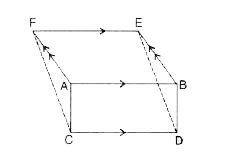A quadrilateral is a parallelogram if its opposite sides are equal.
To prove that a quadrilateral ABCD is a parallelogram if its opposite sides are equal, we can follow these steps:
1. Given Information:
We have a quadrilateral ABCD such that:
- AD = BC (opposite sides are equal)
- AB = CD (opposite sides are equal)
2. Triangles Consideration:
We will consider triangles ABD and BDC.
3. Identify Sides:
In triangles ABD and BDC, we have:
- AD = BC (given)
- AB = CD (given)
- BD = BD (common side)
4. Apply SSS Congruence:
Since we have three pairs of equal sides, we can use the Side-Side-Side (SSS) congruence criterion:
- Triangle ABD ≅ Triangle BDC
5. Corresponding Parts of Congruent Triangles (CPCT):
By CPCT, we can conclude that:
- ∠ADB = ∠DBC
6. Identify Alternate Interior Angles:
The angles ∠ADB and ∠DBC are alternate interior angles formed by the transversal BD with the lines AD and BC.
7. Establish Parallel Lines:
Since ∠ADB = ∠DBC, by the Alternate Interior Angles Theorem, we can conclude that:
- AD || BC
8. Conclusion about the Quadrilateral:
We have established that one pair of opposite sides (AD and BC) are both equal and parallel. Therefore, quadrilateral ABCD is a parallelogram.
Final Conclusion:
Thus, we have proved that if a quadrilateral has its opposite sides equal, it is a parallelogram.
---
We have a quadrilateral ABCD such that:
- AD = BC (opposite sides are equal)
- AB = CD (opposite sides are equal)
We will consider triangles ABD and BDC.
In triangles ABD and BDC, we have:
- AD = BC (given)
- AB = CD (given)
- BD = BD (common side)
Since we have three pairs of equal sides, we can use the Side-Side-Side (SSS) congruence criterion:
- Triangle ABD ≅ Triangle BDC
By CPCT, we can conclude that:
- ∠ADB = ∠DBC
The angles ∠ADB and ∠DBC are alternate interior angles formed by the transversal BD with the lines AD and BC.
Since ∠ADB = ∠DBC, by the Alternate Interior Angles Theorem, we can conclude that:
- AD || BC
We have established that one pair of opposite sides (AD and BC) are both equal and parallel. Therefore, quadrilateral ABCD is a parallelogram.
Thus, we have proved that if a quadrilateral has its opposite sides equal, it is a parallelogram.
Topper's Solved these Questions
Similar Questions
A quadrilateral is parallelogram if its opposite angles are equal.
View SolutionA quadrilateral is a parallelogram, if its one pair of opposite sides are equal and parallel.
View SolutionProve that In a parallelogram, opposite side are equal
View SolutionWhich of the following is not true for a parallelogram ?
a) Opposite sides are equal b) Opposite angles are equal
c) Opposite angles are bisected by the diagonals d) Diagonals bisect each other
View SolutionE,F,G,H are respectively, the mid-points of the sides AB,BC,CD and DA of parallelogram ABCD . Show that the quadrilateral EFGH is a parallelogram and that its area is half the area of the parallelogram, ABCD.
View SolutionWhich of the following statements are true (T) and which are false (F)? (i) In a parallelogram, the diagonals are equal. (ii) In a parallelogram, the diagonals bisect each other. (iii) In a parallelogram, the diagonals intersect each other at right angles. (iv) In any quadrilateral, if a pair of opposite sides is equal, it is a parallelogram. (v) If all the angles of a quadrilateral are equal, it is a parallelogram. (vi) If three sides of a quadrilateral are equal , it is a parallelogram. (vii) If three angles of a quadrilateral are equal, it is a parallelogram. (viii) If all the sides of a quadrilateral are equal it is a parallelogram
View SolutionIf two sides of a cyclic quadrilateral are parallel , prove that the other two sides are equal
View SolutionComplete each of the following statements by means of one of those given in brackets again each: If one pair of opposite sides are equal and parallel, then the figure is ............... (parallelogram, rectangle, trapezium) If in a quadrilateral only one pair of opposite sides are parallel, the quadrilateral is .............. (square, rectangle, trapezium) A line drawn from the mid-point of one side of a triangle .................. another side intersects the third side at its mid-point. (perpendicular to, parallel to, to meet) If one angle of a parallelogram is a right angle, then it is necessarily a .................... (rectangle, square, rhombus) Consecutive angles of parallelogram are ...................... (supplementary, complementary) If both pairs of opposite sides of a quadrilateral are equal, then it is necessarily (rectangle, parallelogram, rhombus) if opposite angles of a quadrilateral are equal, then it is necessarily a ................... (parallelogram, rhombus, rectangle) If consecutive sides of a parallelogram are equal, then it is necessarily a ............. (kite, rhombus, square)
View SolutionIf the sides of a cyclic- quadrilateral are parallel : prove that :
(i) its other two sides are equal
(ii) its diagonals are equal.
View SolutionThe given figure shows a rectangle ABDC and a parallelogram ABEF, drawn on opposite sides of AB. Prove that :
(i) quadrilateral CDEF is a parallelogram, (ii) Area of quad. CDEF
= Area of rec. ABDC
+Area of//gm.ABEF.

View Solution